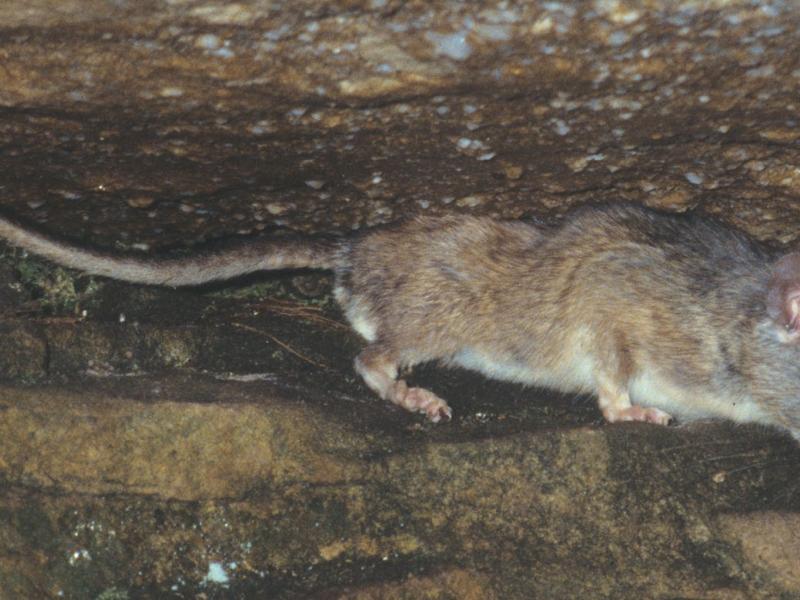Photo Credits: Steven Castleberry
SCIENTIFIC NAME:
Neotoma magister (Baird)
OTHER NAMES:
Pack Rat.
STATUS:
Probably restricted to region north of Tennessee River. MODERATE CONSERVATION CONCERN.
DESCRIPTION:
A large (ave. adult total length = 389.6 mm [15.2 in.], tail = 172.7 mm [6.7 in.], hind foot = 41.8 mm [1.6 in.]; weight = 306.7 g [10.7 oz.]) rodent similar in appearance to the eastern woodrat. Both species have long, thick fur, and large eyes and ears. Pelage varies from buff gray to pale cinnamon on dorsum; ventral surfaces and feet usually white or creamy white. Tail distinctly bicolored and densely furred (Choate et al. 1994, Nature Serve Explorer 2001; Whitaker and Hamilton 1998). Originally considered a subspecies of eastern woodrat, now described as a separate species as result of morphological and genetic differences (Hayes and Richmond 1993). Skulls of Allegheny woodrats have a maxillo-vomerine notch and lack the strongly bifurcate anterior palatal spine found in skulls of eastern woodrats. Allegheny woodrats also similar in appearance to Norway rats. However, Norway rats have long, almost hairless, scaly tails and cuspate molars, whereas molars of Allegheny woodrats consist of prismatic folds (Whitaker and Hamilton 1998).
DISTRIBUTION:
Roughly coincides with central and southern portions of Appalachian Mountain range. Historically found as far north as New York and New Jersey and extended southward to northern Alabama. In Alabama, found north of the Tennessee River and restricted to rock-dominated habitats in northeastern and north-central portions of the state. Studies suggest that the Tennessee River is the lower boundary of the distribution.
HABITAT:
Generally restricted to rocky habitats. Nest in crevices in caves, rock shelters, and bluff faces. Forested rock outcrops also ideal habitats. Mostly associated with hardwood or hardwood/ coniferous habitats, often at higher elevations.
FFEDING HABITS:
Food items include various fruits, nuts, vegetation, and fungi (Balcom and Yahner 1996). Hard mast is an important food source, especially during winter because this species does not hibernate. Mast producing trees are important food sources. Ideal foraging areas usually contain diverse understory vegetation and coarse woody debris that provides a variety of food resources and offers protection from predators.
LIFE HISTORY AND ECOLOGY:
Form small colonies in caves or along rock outcrops. Build large spherical nests (middens) comprised of sticks, shredded bark, and other vegetation. Nests often contain a collection of nuts, bones, trash, and other items gathered over time. Nesting areas consist of a network of runways and several conspicuous latrines. Females will give birth to two to five young in early spring and continue to breed throughout much of the year. Gestation period lasts about 35 days. In warmer climates they may have three to four broods within one year. Young can forage independently within three to four weeks and usually begin breeding within one year. More mobile than most small rodents and have an average home range of 4.4 hectares (10.9 acres). During nightly foraging activities, they can travel more than 1,000 meters per hour (3,280 feet per hour). Lifespan reportedly three to four years (Mengak 1997).
Author:
Travis Hill Henry







